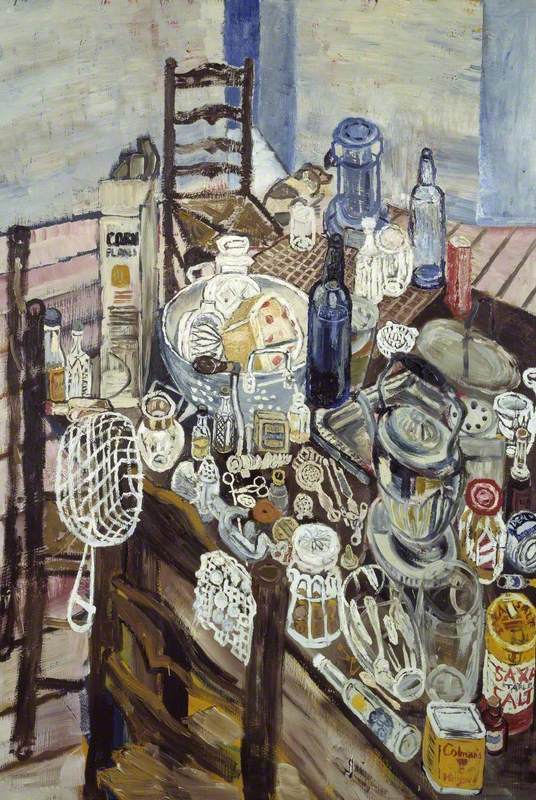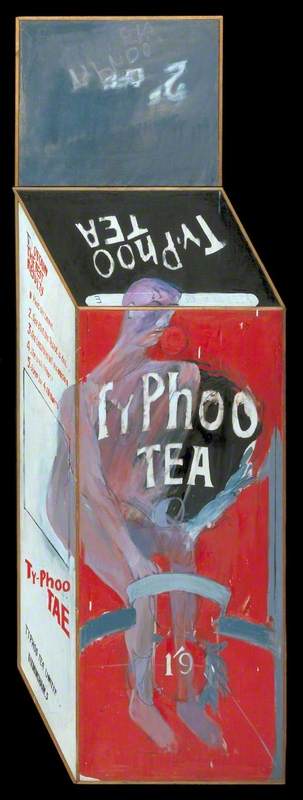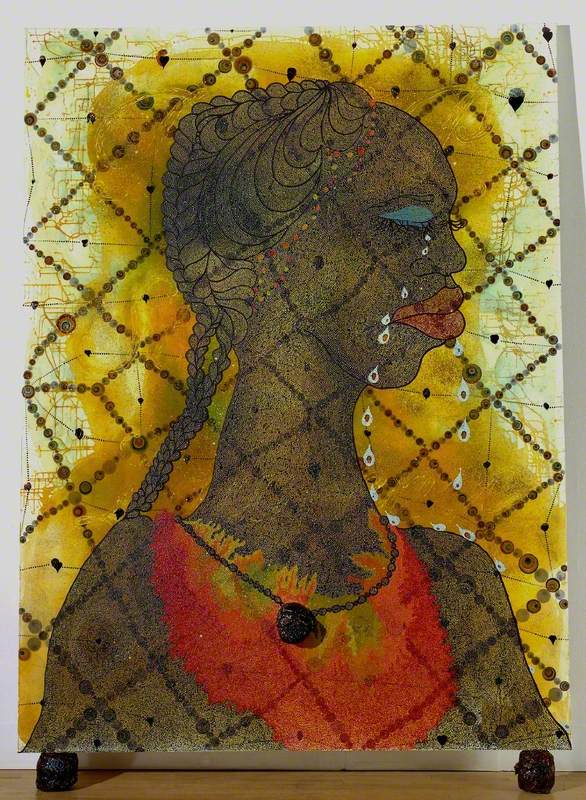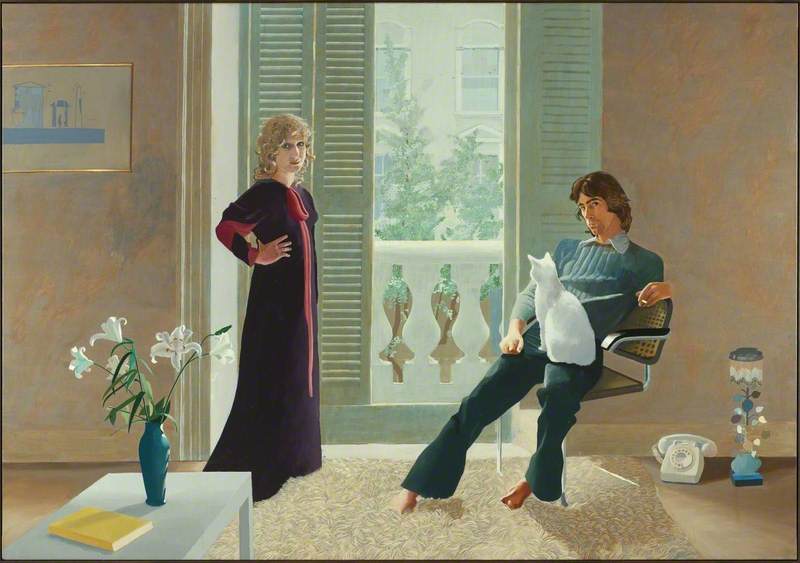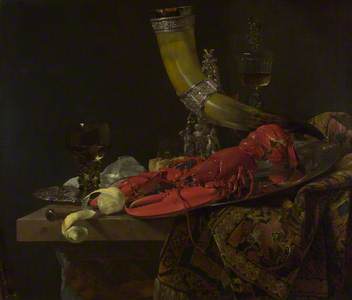The genre of still life has its origins in seventeenth-century Dutch painting. The Netherlands was the first European society to experience the problem of oversupply and overconsumption, and the still-life genre boomed, reflecting this newfound affluence. In such works as Still Life with Drinking-Horn by Willem Kalf painted around 1653, the tabletop is overflowing with a bountiful selection of lavish goods including a lobster, wine and an overly elaborate ivory horn.
Fast-forward to the end of the twentieth century, British artist Patrick Caulfield playfully reimagined this work within a modern restaurant setting. In Reserved Table, Caulfield combined his interest in the formal arrangement of objects with his fascination with imagery taken from tourist brochures, as well as references to art history.
For Caulfield, and other British pop artists working from the 1950s onwards, the context of a new plentiful consumer culture from the United States provided fresh inspiration for their work. Echoing the abundance found in seventeenth-century Dutch painting, they became fascinated with how advertising companies promoted the good life, through lavish presentations of popular commodities and convenience products.
The 1950s was a period of great reconstruction in Britain, with both people and cities recovering from the devastating effects of the Second World War. Rationing had only ended in 1954. The era was marked by a need to restore idealism, and the optimism of American consumerism seemed like an opportunity.
John Bratby's Still Life with Chip Frier is an intriguing precursor to British pop's handling of modern brands and packaging. John Bratby was associated with the 'kitchen sink' painters and the Angry Young Men writers, a group of cultural figures disaffected with the socio-political order of British society. They encapsulated the experience of post-war Britain through their depiction of domestic objects. Still Life with Chip Frier shows a table heaving with things from the kitchen, including mass-produced goods such as Colman's mustard, Saxa salt and Kellogg's cornflakes. The claustrophobia of the image perhaps highlights a feeling of discomfort around this new way of living.
Peter Blake alternatively was fascinated by the proliferation of mass-produced goods, alongside an increasing abundance of visual imagery through advertising, film and magazines. Blake's painting from 1959–1960, Cigarette Pack, demonstrates not only his attraction to popular ephemera and branding, but also his attachment to things that have been overlooked or thrown away. The tiny painting replicates the brand's logo (Belga), but far from the cool, detached replication of branding exemplified in such famous Pop works as Andy Warhol's Campbell's Soup Cans, Blake's work is very much handmade. The open packaging evokes the memory of the person who smoked the last cigarette.
Jann Haworth's approach to mass-produced objects differs from her male counterparts, through her use of sewing and references to quilt-making. Her revolutionary handmade soft sculptures present a wry satire on the mechanised way consumer goods are sold. A significant development in the history of sculpture in the twentieth century, soft sculpture was characterised by the use of cloth, fibre and sewn elements. Artists such as Haworth highlighted the disposability of cloth, subverting the sculpture tradition through an ephemeral material and devalued craft. In Donuts, Coffee Cups and Comic she further subverts the still life genre, through this playful presentation of objects. Doughnuts are a recurrent subject in her work, taking inspiration from the breakfast she would buy at The Big Donut Drive in North Hollywood as a teenager.
Whilst Haworth's still life centres on coffee, David Hockney's early painting, Tea Painting in an Illusionistic Style is inspired by the packets of tea piled up in his studio. Hockney's choice to stretch the canvas in the shape of a Typhoo tea packet was radical at the time, and demonstrates how British artists in the 1960s were expanding the genre of still life to comment on the proliferation of consumer goods and shifting economies. This work was created whilst Hockney was a student at the Royal College of Art in London.
He said: 'the tea packets piled up with the cans and tubes of paint and they were lying around all the time and I just thought, in a way, it's like still-life painting for me. I thought there much be other things lying around, something I could use. This is as close to pop art I ever came. But I didn't use it because I was interested in the design of the packet. These paintings were my first attempt to put recognisable images into paintings.'
British pop artists frequently 'recycled' images, mixing and matching references from art history and glossy adverts in contemporary magazines. Blurring the boundaries between 'high' and 'low' art, these artists used the language of consumer culture to create alluring images, whilst also playing with traditions within painting, in particular, the genre of still life. Artists in the 1950s and 1960s responded to the rise in consumer culture, resulting in witty, often ambiguous representations of aspirational living through still lives focusing on mass commodities. As the current exhibition at Pallant House Gallery, 'The Shape of Things: Still Life in Britain' shows, artists in the past century have used the genre to hold a mirror up to society, reflecting attitudes and ways of living in the contemporary world.
Miriam O'Connor Perks, Assistant Curator at Pallant House Gallery
The exhibition 'The Shape of Things: Still Life in Britain' is showing at Pallant House Gallery, Chichester until 20th October 2024


